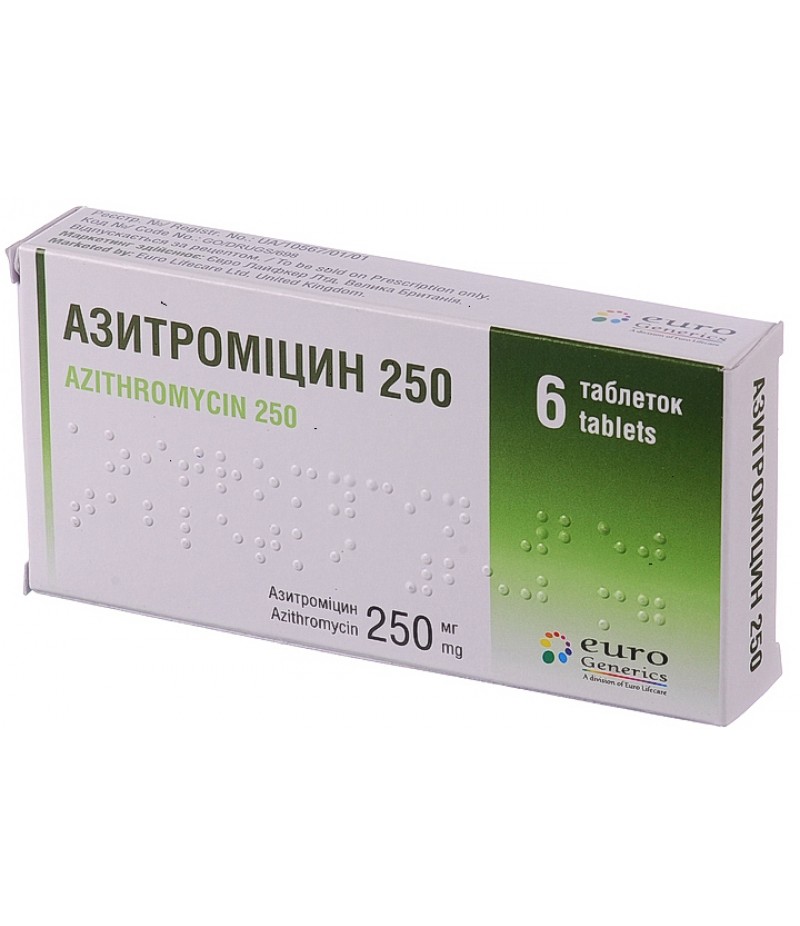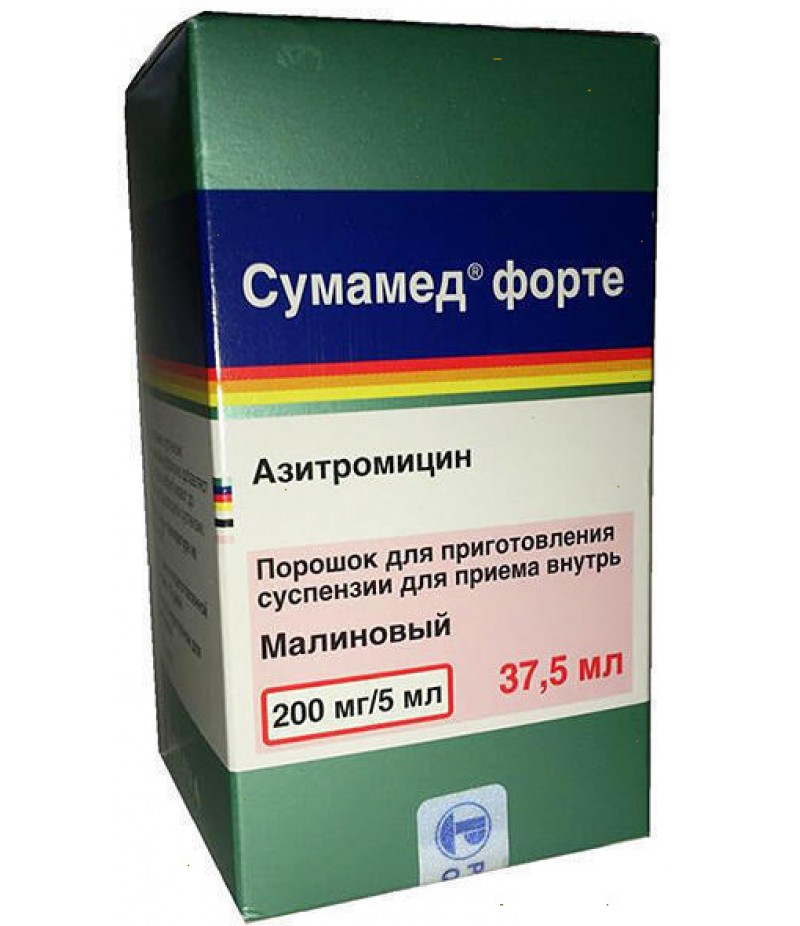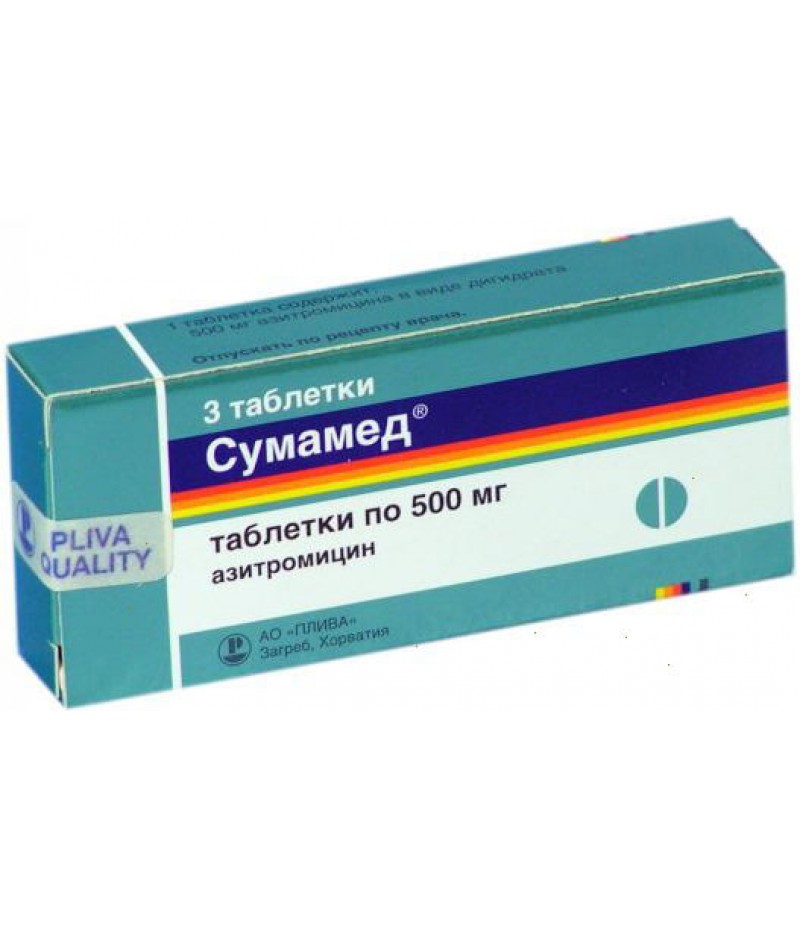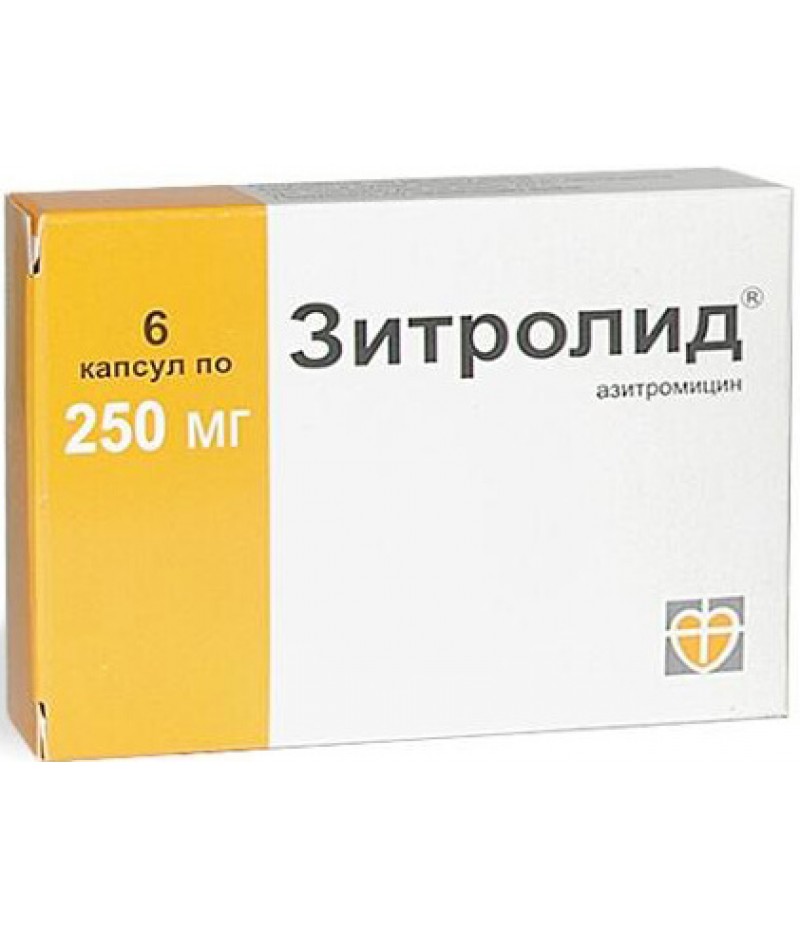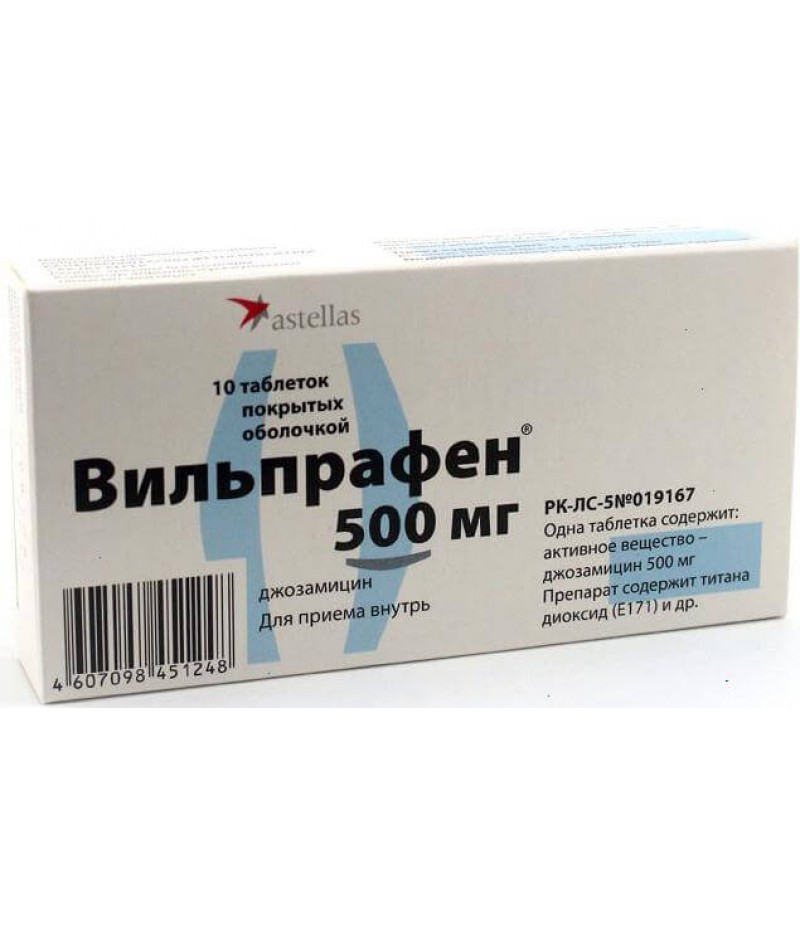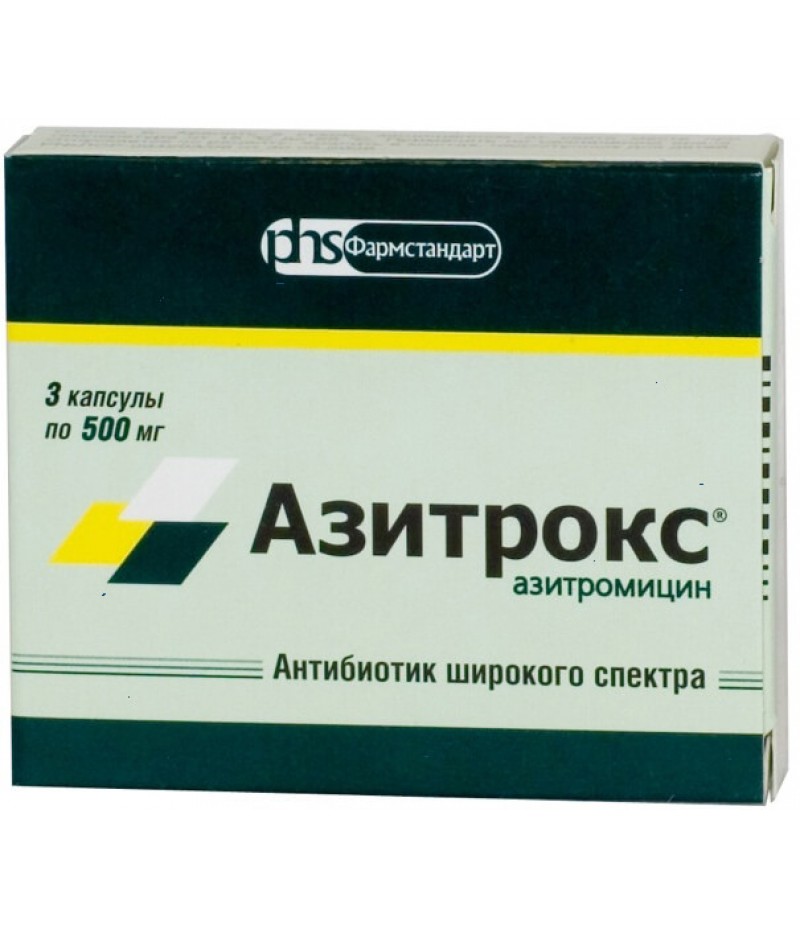Azithromycin 500mg #3
- $7.41
- 3 or more $7.18
- 5 or more $6.90
- Availability:In Stock
Instruction for AzithromycinReed more and buy Azithromycin on this pageCompositionThe composition of 1 tablet includes: Azithromycin dihydrate (at a concentration of 250 or 500 mg Azithromycin), anhydrous lactose, croscarmellose s..
Tags: tabs
Instruction for Azithromycin
Reed more and buy Azithromycin on this page
Composition
The composition of 1 tablet includes: Azithromycin dihydrate (at a concentration of 250 or 500 mg Azithromycin), anhydrous lactose, croscarmellose sodium, anhydrous silicon dioxide in colloid form, magnesium stearate, corn starch, potassium polacrilin, hypromelose, additives E171 and E172, macrogol 4000.
Capsule composition: 250 or 500 mg of active ingredient, lactose in the form of monohydrate, sodium lauryl sulfate, magnesium stearate.
In 1 gram of powder contains 15, 30 or 75 mg of Azithromycin dihydrate. Auxiliary components: xanthan gum, calcium stearate, silicon dioxide, sodium benzoate, sodium carbonate anhydrous, tartrazine, aspartame, ponso, flavor additives "Vanillin" and "Apricot", refined sugar.
Form of issue
Tablets in p / o and capsules 250 mg or 500 mg. Tablets are packaged in packages of 3 or 6 pieces, capsules - 6 pieces each.
Powder for the preparation of oral suspension (100 mg / 20 ml, 200 mg / 20 ml or 500 mg / 20 ml, 20 g in plastic bottles with a measuring cup).
pharmachologic effect
The drug is a broad spectrum of antibacterial action.
Pharmacodynamics and pharmacokinetics
Semisynthetic antibiotic Azithromycin is a synthetic derivative of erythromycin, which belongs to the group of macrolides and azalides (the first representative of azalides).
Linking to the ribosomal 50S subparticle suppresses protein biosynthesis and inhibits the growth of microbes and suppresses their vital activity. In high concentrations shows bactericidal action.
The drug's activity extends to:
Gram (+) microorganisms (except - resistant to erythromycin microflora) - St. aureus and epidermidis; Str. agalactiae, pneumoniae and pyogenes; belonging to groups C, F and G streptococci;
Gram (-) microorganisms - pertussis and a paracolus stick, diplococcus genus Neisseria, hemophilic rod, campylobacteria, bacteria of the genus Legionella, bacteria of the monotypic genus Gardnerella and M. catarrhalis;
anaerobic microflora (Peptostreptococcus spp., B. bivius, C. perfringens, Peptococcus);
Chlamydia (Chl. trachomatis and pneumoniae);
mycopathsites of the genus Mycobacterium;
Mycoplasma (Myc. pneumoniae);
ureaplasma (Ur. urealyticum);
Spirochetes (pathogens of Lyme disease and pale spirochete).
Lipofilen, shows stability in an acid medium. After taking the tablet / capsule or suspension, it is quickly absorbed from the digestive tract.
Bioavailability after taking 0.5 g of the drug is 37%, TCmax - 2-3 hours, the rate of binding to plasma proteins is inversely proportional to the concentration of the substance in the blood and varies from 7 to 50%. T1 / 2 - 68 hours.
The level of Azithromycin in the blood plasma is stabilized after 5-7 days of treatment with the drug.
Easily passing hematoparenchymal barriers, the substance enters the tissues, where it is transported to the foci of infection by polymorphonuclear leukocytes, phagocytes and macrophages, and in the presence of bacteria it is released in the locus of the disease.
It penetrates through the plasma membranes, which makes the drug effective in infections caused by intracellular pathogens.
The amount of substance in tissues and cells is 10-15 times higher than the plasma concentration, the concentration in the pathological focus is 24-34% higher than the concentration in healthy tissues.
After the last administration of the drug, the level necessary to maintain the antibacterial effect is maintained for 5-7 days.
In the liver, Azithromycin is demethylated and loses its activity. Half of the dose taken is excreted with bile (in pure form), about 6% of the substance - by the kidneys.
What heals the drug? Indications for use Azithromycin
Indications for use Azithromycin:
infectious diseases of the respiratory system and ENT organs (tonsillitis, pharyngitis, sinusitis, laryngitis, exacerbated chronic bronchitis, pneumonia, otitis media);
uncomplicated bacterial infections of the urogenital tract (caused by Chlamydia trachomatis cervicitis or urethritis);
soft tissue infections and skin infections (infectious dermatitis, impetigo, besshiha);
scarlet fever;
borreliosis in the initial stage;
Associated with Helicobacter pylori diseases of the stomach / 12-colon.
Contraindications
Contraindications: intolerance to macrolide antibiotics, severe kidney and / or liver pathology.
In pediatrics, the suspension is not used to treat children weighing up to 5 kg, capsules and tablets Azithromycin - for children weighing up to 45 kg.
Side effects
The most common side effects of Azithromycin: visual impairment, nausea, vomiting, abdominal discomfort, diarrhea, decreased blood bicarbonate concentrations, lymphocytopenia.
In less than 1% of patients, vaginal infections, oral candidiasis, leukopenia, efosinophilia, vertigo / dizziness, hypesthesia, syncope, drowsiness, seizures (other macrolides were also found to provoke convulsions), headache, distortion / loss of taste and sensations of smells, violation of the regularity of bowel movement (rare emptying), digestive disorders, anorexia, flatulence, gastritis, increased fatigue; increase of AcAt and AlAt, creatinine and bilirubin of blood, urea, K concentration in the blood; vaginitis, arthralgia, rashes on the skin and itching.
Less than 0.1% of patients developed neutrophilia, thrombocytopenia, hemolytic anemia, mental and motor hyperactivity, nervousness, anxiety, aggressiveness, asthenia, paresthesia, lethargy, neurosis, sleep disorders, insomnia, discoloration, constipation, cholestatic jaundice and hepatitis (including altered PFR indices), angioedema, interstitial nephritis, arthritis, exanthema, urticaria, photosensitivity, Lyell's syndrome, polymorphic and malignant exudative erythema, anaphylaxis, angioedema, candidiasis.
In rare cases, too, a strong palpitation, ventricular aritimia or paroxysmal tachycardia such as "pirouette", chest pain. It was found that other macrolide antibiotics can cause similar symptoms. Also reported cases of arterial hypotension and lengthening of the QT-interval.
Side effects that occur with an unidentified frequency: myasthenia gravis, agitation, fulminant hepatitis, insufficiency of liver function, necrotic hepatitis.
In rare cases, macrolides provoke hearing impairment. Some patients who took Azithromycin were hearing impaired, tinnitus appeared and deafness developed.
Most of these cases were recorded during studies, during which the drug was used for a long time in high doses. The reports indicate that the described problems are reversible.
Instructions for use Azithromycin
Capsules and tablets Azithromycin: instructions for use
Antibiotic take 1 r./d., An hour before a meal or 2 hours after a meal. The missed dose is taken as soon as possible, with the next dose of the drug to be taken 24 hours later.
According to the instructions for the use of Azithromycin, for children weighing more than 45 kg and adult patients, the optimal dosage for cases of soft tissue, respiratory and skin diseases is 500 mg 1 r./day. The course lasts 3 days.
At Lipshutts migrating erythema in the first day take 2 tablets of Azithromycin 500 mg, from 2 to 5 days inclusive - 500 mg / day.
In uncomplicated cervicitis / urethritis, take 1 g of the drug once.
Capsules Azithromycin (Astropharm, Health, BHFZ and other manufacturers) are taken in a similar way.
Scheme of treatment for ureaplasma
When ureaplasmosis treatment should be carried out on the principle of complexity.
A few days before the start of Azithromycin, the patient is prescribed immunomodulators. The drug is injected into the muscle 1 p. / Day. with an interval of 1 day. Injections continue to be done throughout the course of treatment.
Simultaneously with the second reception of the immunomodulator, a bactericidal antibiotic is started. When it is completed, go to Azithromycin. During the first 5 days the drug is taken daily for 1.5 hours before breakfast at 1 g.
After this time, stand a 5-day break and again, adhering to the recommendations in the annotation to the drug, take 1 g. After 5 days, Azithromycin is taken at the 3rd, last, time. The dose is the same - 1 g.
Within 15-16 days, while treatment with Azithromycin is continuing, the patient also should be 2-3 r. / Day. take stimulators of the synthesis of their own interferons, as well as antimycotics polyene series.
After a course of antibiotics, rehabilitation therapy with drugs that normalize the function of the digestive tract and help restore its microflora is indicated. Supportive treatment is continued for 2 weeks or more.
Scheme of treatment for chlamydia. Capsules and tablets - from what they are effective at a clamidiosis?
Azithromycin is a means of choice for chlamydia in the lower parts of the genitourinary system, as it is well tolerated by patients, and, in addition, can be used to treat teenagers and during pregnancy.
With this form of infection it is taken 1 time in a dose of 1 g.
If the chlamydial infection affects the upper sections of the urogenital tract, treatment is carried out in short courses, and between courses are maintained at long intervals.
The course of treatment is designed for 3 doses. The dose for 1 reception is 1 g. The interval between doses is 7 days, that is, the medicine is taken on days 1, 7 and 14. This scheme was approved by the Ministry of Health of Russia to treat persistent / complicated forms of chlamydia.
How to take Azithromycin with angina?
All antibiotics intended for the treatment of angina take a ten-day course. Azithromycin is an exception to this rule - it is prescribed for 3-5 days.
Another advantage of the drug is that it is tolerated by patients much better than the penicillin series (macrolides are considered the least toxic antibiotics).
Adults and children weighing more than 45 kg are prescribed to take 500 mg / day. If, for some reason, the admission was missed, the next dose is taken immediately, as soon as this circumstance is discovered, and the next dose is taken at 24-hour intervals.
Children aged between six months and 12 years are shown taking the suspension. Drink an antibiotic should be 1 time a day. Treatment lasts at least 3 days, the dose is selected individually.
Reviews about Azithromycin in angina are positive, because even with purulent angina the patient's condition improves substantially after 5-6 hours after the first tablet was taken.
Antibiotics for sinusitis. Azithromycin - from what these tablets at a genyantritis?
Azithromycin for sinusitis apply one of the following schemes:
shock dose (500 mg) on the first day, then 3 days for 500 mg;
shock dose (500 mg) and another 4 days for 250 mg.
Children under 12 years are prescribed a suspension. The drug is dosed at the rate of 10 mg per 1 kg of the child's weight. The medicine is given to the patient 1 p. / Day. three-day course. In some cases, the child is recommended to give 10 mg / kg of Azithromycin in the first 24 hours, and lower the dose to 5 mg / kg in the next 4 days. The highest dose per course is 30 mg / kg.
Azithromycin in sinusitis, accumulating in the hearth, suppresses the Gram (+) bacteria, which are the main cause of its development, and effectively removes inflammation in the sinuses of the nose.
Overdose
Overdose is accompanied by severe nausea, vomiting, stool disorder, temporary hearing loss.
Therapy: symptomatic.
Interaction
Absorption of the drug is reduced in combination with Al3 + and Mg2 + -containing antacids, food and ethanol.
The combination "macrolides + warfarin" can provoke an increase in anticoagulation effect, so patients taking Azithromycin in combination with warfarin - despite the fact that studies have not revealed changes in prothrombin time when they are taken in usual doses - careful monitoring of this indicator is required.
Unlike other macrolides, it does not interact with Terfenadine, Triazolam, Theophylline, Digoxin, or Carbamazepine.
Simultaneous use of Terfenadine with various antibiotics provokes prolongation of the QT interval and arrhythmia. On this basis, Azithromycin is used with caution in patients who take this medication.
Macrolides increase plasma concentration and toxicity, and also slow the elimination of Methylprednisolone, Cycloserine, Felodipine, indirect coagulants and undergoing microsomal oxidation of drugs, however, in the case of Azithromycin (and other azalides) this type of interaction was not detected.
The effectiveness of the drug is increased in combination with Chloramphenicol and Tetracyclin and decreases in combination with lincosamides.
With heparin, Azithromycin is pharmaceutically incompatible.
Storage conditions
The drug (in any dosage form) should be stored at a temperature of 15-25 ° C in a place protected from moisture and light. The storage temperature of the finished suspension is from 2 to 8 ° C.
Shelf life
For powder and capsules - 2 years. For tablets - 3 years. Suspension is considered usable for 3 days.
special instructions
Vidal points out that, since Azithromycin is metabolized in the liver, and the substance is excreted primarily with bile, the drug should not be used to treat patients with severe impairment of liver function.
Patients of advanced age do not need to adjust the dose. However, since the electrical conductivity of the heart may be impaired in the elderly, prescribing the drug may increase the risk of cardiac arrhythmias and the development of pirouette tachycardia.
The use of Azithromycin IV, according to Wikipedia, is contraindicated in patients younger than 16 years.
Peculiarities of pharmacokinetic profile of the preparation
The pharmacokinetic parameters of the preparation are significantly influenced by the intake of food, and how much the changes are expressed also depends on its dosage form.
Thus, food intake helps to reduce Cmax Azithromycin in the form of capsules and increases this figure for the tablet form. In the first case there is a simultaneous decrease in AUC, in the second - this indicator remains unchanged.
In old age, in women, unlike men of the same age group, the parameters of pharmacokinetics change, namely, Cmax increases.
In children from 12 months to 5 years, there is a decrease in AUC, Cmax, T1 / 2.
Azithromycin for children
The use of tablets and capsules is possible if the body weight of the child exceeds 45 kg. Dosage Azithromycin for children weighing 45 kg is determined depending on the indications.
Children weighing more than 45 kg are given capsules or tablets with a dosage of 250 mg or 500 mg.
At a young age, the optimal dosage form for children is a suspension.
Bad reviews about the treatment of children with the use of Azithromycin - a rarity. High concentration of the drug in the focus of inflammation inhibits the activity of bacteria and prevents the infection from spreading further. The child's respiratory function improves, the temperature decreases, the sore throat and weakness decrease.
An important feature of the medication is that 3-5 days of treatment are sufficient to achieve a therapeutic effect, since the drug continues to function for a week after completion of the course.
Compatibility with alcohol
The instructions do not indicate the interaction of Azithromycin and alcohol, however, this does not mean that the intake of alcohol during treatment is allowed. Alcohol reduces the absorption of the drug, slows the rate of metabolic processes, increases the load on the liver, provokes intoxication and death of hepatocytes.
A single dose of a small dose of alcohol is allowed no earlier than a couple of days after the completion of the course of treatment.
Azithromycin during pregnancy
During pregnancy and breastfeeding, the drug is prescribed when the benefit of treatment for the mother exceeds the potential risks of using Azithromycin for the fetus / child.
Reviews on Azithromycin during pregnancy, compiled by Canadian researchers in the framework of the Motherisk Program, convincingly prove the safety of the drug for the treatment of expectant mothers.
In all control groups (Azithromycin was taken in the first woman, in the second - other antibiotics, in the third - did not receive antimicrobial treatment), the frequency of severe developmental malformations in the fetus did not differ significantly.
Reviews about Azithromycin
Reviews about Azithromycin with chlamydia, angina, sinusitis, frontitis and other diseases that are caused by drug-sensitive microbes are overwhelmingly good.
The drug is a powerful tool for combating bacterial infection and is well tolerated by patients, and associated with its use of side effects, occur infrequently and completely disappear after discontinuation of treatment.
The doctors' comments about the drug are also positive. The main advantages of Azithromycin, according to doctors, is that he:
has anti-inflammatory and immunomodulating action;
is characterized by high activity in relation to probable pathogens of infectious diseases of the respiratory system;
creating high concentrations in tissues, exhibits bactericidal properties against H. pylori, H. influenzae, N. gonorrhoeae, M. catarrhalis S. pyogenes, S. pneumoniae, S. agalactiae, B. pertussis, Campylobacter spp., C. diphtheriae;
is effective in relation to atypical pathogens, which multiply inside cells (in particular, with respect to mycoplasmas and chlamydia);
can be used in pregnancy;
has a dosage form suitable for children.
Azithromycin has a post-antibiotic effect, which allows its use in short courses. In addition, under the influence of the drug even microbes resistant to it become more sensitive to the effects of immune defense factors.
Unlike erythromycin, which is the basis of macrolide antibiotics, Azithromycin does not decompose in the acidic environment of the stomach and to a lesser extent affects the motility of the gastrointestinal tract.

